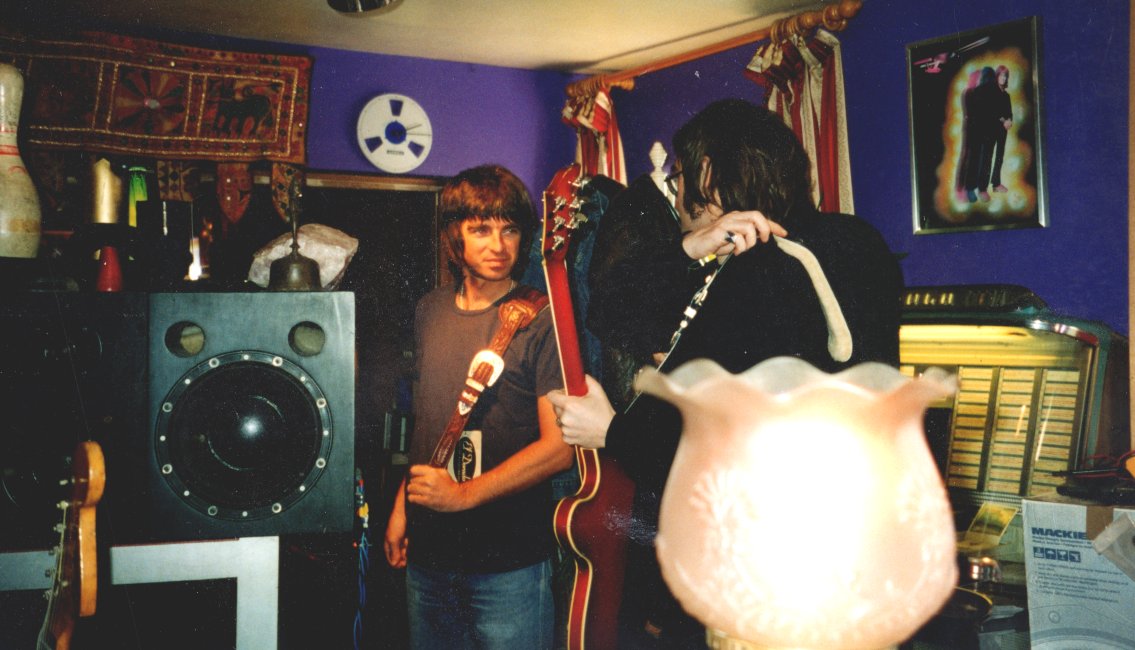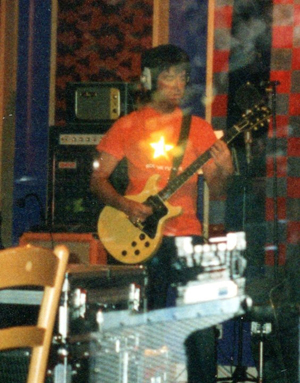This Noel Gallagher interview from the September 2002 issue of Guitar One magazine is reproduced on Oasis Recording Info by kind permission of Michael Clark of Clark Amplification. Please click here to visit the Clark website! Photos of Oasis at Wheeler End Studios reproduced by kind permission of Stuart Epps; click on this page to read Stu’s Story on his website.
What instruments and amps did you use on the Giants sessions?
Noel: For this album, I decided that I wasn’t going to use anything that I’d used on any of the previous three albums. I put away all the guitars and Marshall stacks I’d used on Morning Glory, Be Here Now, and Definitely Maybe. Then I bought loads of really weird pedals, old guitars, and small amps. In the past, I would just have a couple of 100-watt Marshalls, a Les Paul, and my Epiphone Casino, and that would be it. I wouldn’t even try to experiment with guitar sounds, because I couldn’t be bothered.

Above: Noel and Liam recording demos for Standing on the Shoulder of Giants at Wheeler End Studios in 2000. Photo reproduced by kind permission of Stuart Epps.
So what prompted you to toss out your old faithfuls?
Well, again, I had the time. There was no pressure to have the record released by a certain date. When somebody gives you an infinite amount of time to produce a record, you tend to take quite a few days just messing around.
What were some of the “new” instruments you used?
A Fender Strat and a ’60s Telecaster that Johnny Depp bought me for my 30th birthday. And I just bought this really cool, wine-red ’80s Les Paul Deluxe. But it wasn’t so much the guitars that changed the sound of the album – it was the amps. For example, I’d never used a Fender amp on any of my records. It was always Marshalls, Marshalls, and more Marshalls.
Did you try a bunch of Fenders, or stick with one or two models?
The main amps were a Bandmaster and a blackface Princeton.

Above: Noel Gallagher recording at Wheeler End Studios during the demo sessions for Standing on the Shoulder of Giants. Photo courtesy Stuart Epps.
What were some of the tonal differences you noticed between the Marshalls and the Fenders?
No disrespect to Marshall, but they have one sound, and that’s just about it. They’re either really loud, or really quiet. But I found that each Fender amp has its own character.
Then I assume that you used the Bandmaster and the Princeton for specific sounds?
Yeah. I used the Princeton for clean sounds, and the Bandmaster would just be for loud, dirty sounds.
Are you bringing the Fenders on the road, or are you sticking with the Marshall sound for live performance?
Well, neither, actually. I’m using Clark amps – they’re made buy a guy in America. Spike [Stent, Giants co-producer] downloaded the information from the Internet, and I was intrigued by Clark’s claim that he could replicate any tweed Fender, but with sturdy hardware so that they don’t rattle around on tour. We couldn’t try one out beforehand – because he only makes amps to order – so we took a gamble and sent him some money. Four months later, this amp turns up at our rehearsal studio. We plug it in, and it sounds five times better than my Bandmaster! I don’t know what this guy does, but he’s a genius.
Which Clark model did you order?
It’s a Tyger, which is based on a late-model tweed Bandmaster. Spike ordered a replica of a ’59 tweed Deluxe which Clark calls the Beaufort.
How do you dial in your live sound?
I used to just turn up the amps as full as I could get them – I never used distortion pedals or anything like that. But I started collecting Ibanez Tube Screamers recently, and I’ve got an old ’70s model, which is the best pedal I’ve ever come across. So now I get a really good rhythm sound, and then kick in a Tube Screamer for the guitar solos. I like that so much better than having a loud guitar sound going all the time.
Good tone, and – as a bonus – you’re probably saving your hearing.
Absolutely – and the rest of the band’s, too [Laughs].
(Interview © Michael Clark and Guitar One magazine, 2002. Photographs by Stuart Epps, 2000. Republished on Oasis Recording Info, 2012).
